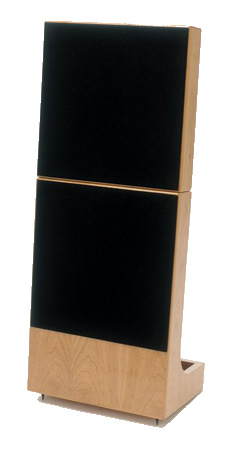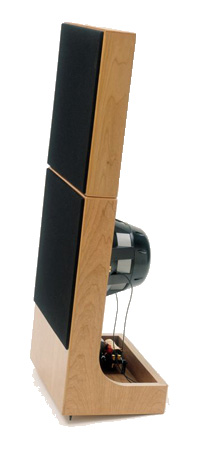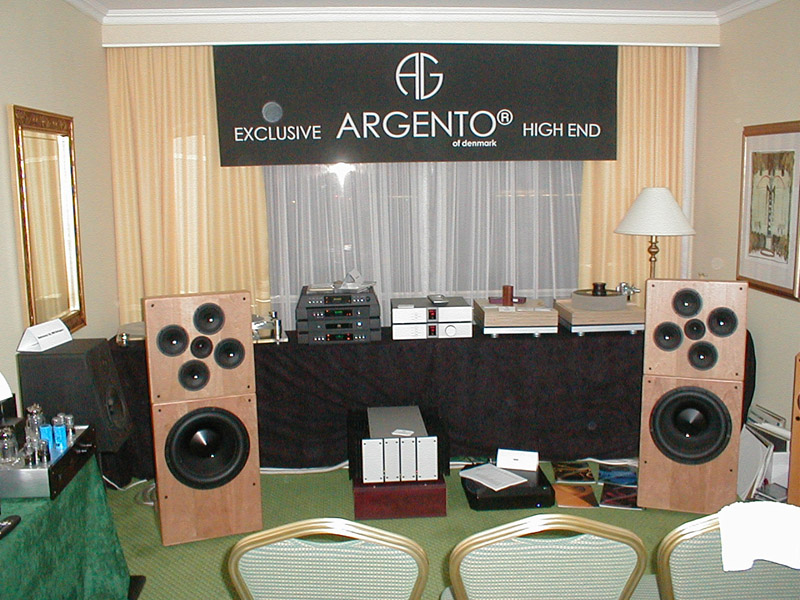 ™
™
 ™ ™ |
 |
 |
 |
|
Presenting the DNA™ Sequence™ speakers, where form follows physics™. The DNA Sequence loudspeakers are specially created with one goal: Produce the best possible sound in-room at the listening postion. How is this goal accomplished? The resulting design is the culmination of 12 years of listening, research, and development. Comments from listeners include: "This might be the best midrange I've ever heard. They remind me of original Quads." Elliot Midwood, Acoustic Image "These have the speed and attack like an electrostatic loudspeaker. How are you doing it?" Rainier Israel, Hi-Fi distributor in Germany "They possess the clarity of studio master tapes." Geoffrey Dillon, audio guru "You should be proud. I hope you do well." Andrew Kotsatos, founder of Boston Acoustics "Filed under the weird and wonderful were the Nordic Concept Turntable from Sweden and Sequence speakers from Donald North Audio. Another charmer, North explained his Sequence speaker design carefully and the design behind the fascinating Nordic turntable. The sound in this room was very musical - with an intriguing look to match." Anthony Kershaw of Audiophilia reporting on CES 2003 Here's why: The theoretical goal of a loudspeaker system is to reproduce the sound field as when it was originally made. To properly design a loudspeaker, it must first be understood how sound fields are recorded and the environment in which the playback will typically occur. When sounds are created, the sound waves (energy) are radiated in all directions. This total energy can be considered a sound field. A person listening to the original acoustical event is of small size in relation to the size of the total sound field and could be considered as a point in the sound field. Likewise, when sounds are recorded, they are captured with a microphone, which is also of small size in relation to the sound field and would also be considered as a point in the sound field. When reproducing such sounds, the optimum playback mechanism is through an acoustical point source. A point source is a theoretical, infinitely small sound source capable of reproducing all frequencies from the same physical location. Once example of a point source is a single transducer. Unfortunately, no single transducer can reproduce sounds uniformly at typical listening levels over the entire audio frequency spectrum with minimal distortion or coloration. To overcome some of the limitations of single transducer systems, most loudspeakers use multiple transducers of different sizes to reproduce the full range of the audible frequency spectrum. The most common approach is to use a small transducer optimized for high frequency reproduction (tweeters) mounted near the top of the enclosure at ear level and one or more larger transducers optimized for low frequency reproduction (woofers) below the tweeter. With this approach, however, the speaker system no longer emulates a point source, and the human ear is sensitive to the direction of sound and can notice the different physical locations of these transducers. To compound the problem this traditional arrangement also yields different path lengths from each transducer to the listener so that the respective sounds do not arrive all at the same time. The resultant reproduced sound field does not sound like the original source. Hi-fi loudspeakers are typically used indoors. When they reproduce sound, the generated sound waves travel in all directions. Ideally, the listener should hear only the sound waves traveling towards him/her. In actuality the listener hears these direct sound waves and those reflected waves which bounce off the room's surfaces, primarily the walls, floor, and ceiling. Since these reflected sound waves have traveled a longer distance to the listener than the direct waves, they are delayed in relation to the direct sound. The waveform heard by the listener is incorrect, being distorted by the combination of the direct and reflected sound. Thus, the listener is not hearing the sound field as it was originally generated or recorded and, instead, is hearing a severely distorted sound field that bears little resemblance to the original event. At lower frequencies, typically from 200 Hz and below, these reflections form into acoustic standing waves within rooms, based on the size and geometry of the room. Conventional closed box and ported box loudspeakers at these lower frequencies are essentially omnidirectional, radiating sound equally in all directions, much like a point source. This omnidirectional sound radiation easily interacts with and excites these standing wave room modes, resulting in an uneven, unnatural bass response. The DNA™ Sequence™ loudspeaker solves these problems by maximizing the sound directed towards the listener while minimizing sound being directed towards first-reflective surfaces (floor, side walls, ceiling) and into standing wave room modes. This is accomplished through the clever use of a proprietary time-aligned, directional, point-source, high efficiency, quad midrange - tweeter satellite array and dipole woofer. I know of no other commercial speaker which can make all these claims. When the speakers are properly positioned, they are angled directly to the listening position. When seated, your ears are at the same height as the tweeter and the center of the midrange array. The sound path length to the ears is identical for all 4 midranges, so they arrive at your ears at the same time. However in relation to the floor, side walls, and ceiling, the midrange array is 4 unique distances away and causes destructive interference, thereby reducing the sound levels of the primary reflections. While other companies spend thousands of dollars on advertising to lure and dupe prospective customers touting dubious innovations like aspherical group delay or flaunting some Japanese audio Grand Prix award, they fail to address the basic yet essential goal of reproducing a flat frequency response in-room at the listening position. This makes one wonder, exactly what fundamental improvements in sound reproduction have they accomplished, particularly among those manufacturers who allegedly have been refining (more like rehashing) the same design over and over again with one version after the next? With the DNA Sequence speakers their patented innovation is immediately apparent by the uniqueness of their design and witnessed sound quality. Features of the DNA Sequence™ loudspeakers include:
Specifications:
U.S. Retail price: $20,000 system with triode active crossover
DNA Sequence loudspeakers are sold factory direct in North America. Also on display
in Stockholm, Sweden: . |
 |
 |
DNA Sequence on display at CES |
 |
|
DNA
Sequence on display in Copenhagen, Denmark
|
 |
 |
Copyright © 2001 - 2008 Donald North Audio. All rights reserved.
